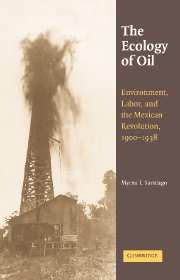Book contents
- Frontmatter
- Dedication
- Contents
- List of Maps, Figures, Tables, and Appendices
- Acknowledgments
- Introduction
- PART ONE THE HUASTECA BEFORE OIL
- PART TWO THE ECOLOGY OF OIL
- PART THREE CHALLENGING THE ECOLOGY OF OIL
- Conclusion
- Epilogue
- Appendices
- A Note on the Sources
- Archives Consulted
- Selected Bibliography
- Index
Conclusion
Published online by Cambridge University Press: 05 March 2015
- Frontmatter
- Dedication
- Contents
- List of Maps, Figures, Tables, and Appendices
- Acknowledgments
- Introduction
- PART ONE THE HUASTECA BEFORE OIL
- PART TWO THE ECOLOGY OF OIL
- PART THREE CHALLENGING THE ECOLOGY OF OIL
- Conclusion
- Epilogue
- Appendices
- A Note on the Sources
- Archives Consulted
- Selected Bibliography
- Index
Summary
As headlines alert us to “the end of cheap oil” and scientists begin publishing books about running Out of Gas, it seems appropriate to ask, “What exactly did petroleum extraction entail?” The case of northern Veracruz from 1900 to 1938 provides a template: oil produced its own ecology. That is, the oilmen, those who owned and conducted the industry, carried out major social and environmental changes in the sites where they operated, unwittingly or not. The transformations encompassed three broad areas: land tenure systems, land use, and the social composition in the territories under production.
The transformation of social groups and land tenure and usage included further changes, connected to the broader processes like aftershocks to an earthquake. The shifts in land tenure the oilmen wrought meant they accumulated land and concentrated it under their control, displacing the local owners, indigenous Huastecs and hacendados alike. The purpose of securing power over the land, in turn, was to change its uses. Local patterns of production, indigenous small-base subsistence farming, and hacendado cattle ranching gave way to oil extraction, transportation, and refining. Building the infrastructure for the petroleum industry, moreover, entailed extensive changes in the land, often radical enough to eradicate existing ecosystems altogether. In the Huasteca that meant degrading or destroying estuaries, marshes, mangrove forests, sand dunes, and the northernmost tropical rainforest in the Americas. Oil extraction and refining, as well, led to chronic pollution. The air, land, and water of the Huasteca became tainted with and by hydrocarbons and other toxic compounds, as spills and fires spread over the landscapes of northern Veracruz, southern Tamaulipas, and the open waters of the northwest curve of the Gulf of Mexico. All living organisms in the area felt the effects deeply, as nothing had caused such dramatic environmental disruption since the arrival of the Spaniards in the fifteenth century.
Social changes were also part and parcel of oil production. The labor demands of mounting an enterprise of such scale required importing workers by the thousands. The rapid arrival of immigrants in high numbers resulted in the displacement and marginalization of the indigenous population, reducing their social and political weight and participation and, hence, their opportunity to reap rewards from the wealth oil created. New social groups, moreover, entailed new social relations. In the Mexican oil industry those relationships were determined by capitalism and racism.
- Type
- Chapter
- Information
- The Ecology of OilEnvironment, Labor, and the Mexican Revolution, 1900–1938, pp. 343 - 348Publisher: Cambridge University PressPrint publication year: 2006

